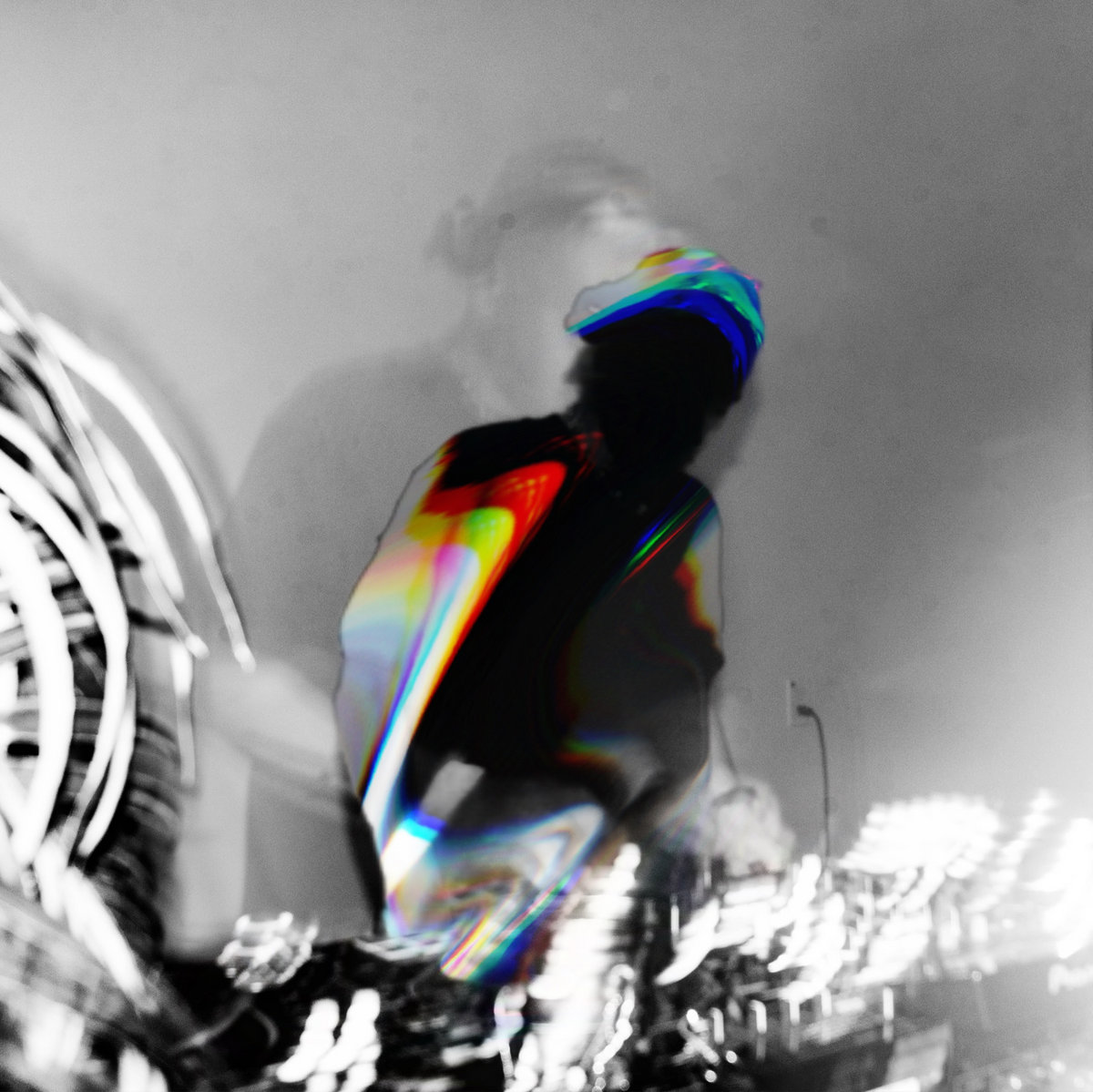Imaabs: A Unique Force in Latin American Electronic Music
The Chilean-born artist who is a boundary-pushing force in Latin American electronic music. As a producer, DJ, and NAAFI’s Label Manager, he blends philosophy with sound, forging global connections. An ever-evolving journey, that shapes a unique musical identity.

Chilean musician Cristo Gavras, also known as Imaabs, is difficult to place within the biggest orbits of electronic music. His sound is informed by techno, yet it defies categorization. Originally from Chile, he has strong ties to Mexico City and has collaborated with institutions like NAAFI and Hiedrah Club de Baile. His work extends across Latin America, where he nurtures relationships with labels, artists, and creatives.
A Unique Musical Identity
Imaabs fits into many different spaces while simultaneously occupying a unique space. Since 2014, his music has been shaped by an expansive network of artists and labels that he supports, bonds with, and collaborates alongside.
As one of the leading mixing and mastering engineers for NAAFI, he has recently stepped into the role of Label Manager. His connection with Mexico began through Tomás Davó, NAAFI’s manager, and Eric Gamboa, who used to work for media outlet Remezcla and was running the label/media NWLA. Eric was the one who introduced Cristo to ZutZut (Alejandro Nuñez) and Lao, who had a blog called 401 together. In 2014, after performing at the first Club Viral in Monterrey, he quickly developed a strong relationship with the label.
Shortly after, he moved to Mexico City, cementing his relationship with the collective.
A Discography of Influence
His creative output includes albums, EPs, and collaborations that showcase his distinctive style: Album Descifrar, Eps like Distancia, La Devoración with Kali Mutsa, Extravío with Lia Nadja & Felicia Morales, remixed by MESH, and tacks like Costa Brava with Merca Bae. A catalogue of Releases that keep on growing. that grows until today. Becoming a DJ, live act, producer and mixing and mastering engineer he collects the important tools that give him the freedom to realize ideas on a multitude of creative levels.
His extensive involvement in Latin American electronic music, as well as his presence on global stages, has made him one of the region’s most intriguing figures. Besides releases on labels like Diamante Records, Trax Couture, PTP, NAAFI and Hierdah Club De Baile, his own Bandcamp page hosts 19 releases, mostly self-released, including his latest works: Frialidad, Sentimentalismo y Crueldad.
Imaabs quickly became an international touring artist, forging friendships and networks worldwide. He strengthened ties with Argentina’s Hiedrah Club de Baile, mixing and mastering their catalog, after connecting with Lechuga Zafiro and fellow Chilean artist Baltazar Solar (Alpha Stronggah).
A Philosopher Turned Musician
Imaabs artistic vision is deeply rooted in philosophy, a subject he once taught in Chile. This intellectual foundation informs his sonic identity. His journey took a major turn in 2012 when he met Tomás Urquieta, who became his close musical confidant.
„I've known Tomás Urquieta since Chile, in 2012; we did several projects together, parties and music. Through Tomás, I met David Silva (Practice - Loe) in 2021, and from there we started making music together.”
In 2021, the three artists formed cr1s1s, a live project focusing on raw, forceful, and minimal techno, stripped of rhythmic complexity and ambient abstraction.
A Journey Through Time
Our conversation about his path in electronic music began two years ago when he was still living in Chile and planning a return to Mexico. Three years later, I met him in Mexico City in person.
Imaabs story is one of constant evolution, community-building, and boundary-pushing creativity, making him one of the most compelling figures in Latin American electronic music today.
The interview took place in 2022 over ZOOM and has been edited for flow, clarity and length, and contains additions from later emails and exchanges.
Sophie: How long have you been an artist?
Imaabs: It’s difficult to consider myself as such, but I try to do it since I was 14 years old when I was 14 years old when I started a a bass player, and as Imaabs, I started 2008.
Sophie: How did you come to connect with Mexico City?
Imaabs: By Eric Gamboa and later by Tomas Davó, director of NAAFI.
Sophie: And when did you first come to Mexico and why?
Imaabs: In July 2014 I played at the Antes Festival and the first Club Viral in Monterrey.
Sophie: It says that you’re between Mexico and Chile. Does that mean you live in Chile and travel to Mexico sometimes?
Imaabs: My last trip was to explore emigrating to Mexico City, but I came back [to Chile] because I’m working on music for a contemporary play. The project is tied to government funding that some friends of mine secured back in 2019 or 2020. I feel a responsibility to return and complete it. Right now, I’m working on music for the next piece, and the premiere is scheduled for March [2021].
Sophie: So, it’s part of a series?
Imaabs: Yes. But during the pandemic, I began consolidating my work as a sound engineer, focusing on mastering and mixing. At the same time, I want to continue researching sound, art, and performance. I feel it’s something I need to pursue. I’m also exploring similar projects in Europe because I don’t want to give up that side of my life—it’s something I love deeply.
Sophie: It sounds fascinating to work in such different fields. Contemporary dance and theatre seem so different from electronic music, which is often consumed through headphones or in clubs. Producing music for these spaces must require entirely different approaches.
Imaabs: Definitely. For me, it’s an opportunity to connect theory with practice. I studied philosophy and taught it for a while, so I enjoy exploring theoretical concepts around music, sound, and performance. It allows me to be completely myself, especially with my solo music projects. However, when I work with others, it can be more challenging. I often seek out artists who are also interested in critical theory, poetry, or similar areas because it aligns with my perspective.
Another interesting aspect is how artists want to blend club music into their art projects. I’ve been able to combine club sounds with ambient, experimental music, and sound design. It’s exciting, but it can also feel overwhelming at times.
Sophie: I’d love to know more about your background. Are you a philosophy teacher?
Imaabs: Not exactly. I studied philosophy to become a secondary school teacher, and I also taught at a university for a while. But I left academic philosophy around 2013. My research at the time was focused on themes like prisons and power, mostly through the lens of French philosophy.
I’ve also been involved in music for a long time. I started as a bass player and played in bands for most of my life. The Imaabs project began in 2007, but I became more professional around 2012-2013, starting to tour and produce music. I never imagined I could tour the world.
In 2015, I met L-Vis 1990 in Chile. He told me, “You can tour globally. People love your music.” I couldn’t believe it. Later that year, I did a 3-4 month world tour. It was exhausting, precarious, and financially challenging, but it was an amazing experience. By 2017, my tours were smoother, but I still can’t believe I’ve played in places like Europe, the US, Japan, China, and Australia.
Sophie: That’s incredible.
Imaabs: It is. When you start out, it feels like only upper-class people can do that kind of traveling. But over time, connections with producers and musicians made those distances feel smaller. Now, I have friends in Berlin, Brussels, and Paris. I’m still not part of the upper class, but I’ve built a network.
In Chile, I know only one other artist doing something similar: Tomás Urquieta. His music is amazing—minimalist, politically sharp—and I think that’s why people around the world pay attention to us.
Sophie: He’s the one who told me about you! I was researching people working in Chile, and your name kept coming up. You also have a studio for mixing and mastering called Modos, right? Mixing engineering seems like a fascinating intersection between contemporary and club music. I’d love to hear your perspective on that, especially since your work feels cinematic, almost like a horror film soundtrack.
Imaabs: That’s an interesting observation. For example, NAAFI’s release PIRATA was a compilation of bootlegs. A lot of people in Europe associated NAAFI with experimental music, even though it wasn’t exactly reggaeton or “carnival music.” That’s an example of how complex the concept of “Latino” can be. It’s not a single identity—it’s a blend of cultures, politics, and perspectives, almost baroque in its complexity.
Sophie: Can you talk more about your relationship with production and mastering? How did you get started, and what challenges have you faced?
Imaabs: In 2012-2013, I didn’t fully understand mastering. When I released music with Trax Couture, the tracks sounded incredible, and I s
tarted to grasp how important the low end was—especially after working with hip-hop and R&B. Here in Santiago, pop-focused studios don’t emphasize the low end as much, but I think it’s crucial. That’s one thing that sets my studio apart.
Currently, I’m working on improving my sound even further. For example, I’m collaborating with Hiedrah Club de Baile on their first releases. It’s a vital project for me, and I’m willing to invest whatever it takes to develop their sound.
I’ve also decided to focus exclusively on digital production for practical reasons. I don’t have a permanent workspace, but I dream of opening a studio in Mexico. It’s a nomadic way of thinking about music, which I find exciting.
Sophie: That’s so interesting. I’ve noticed people in Europe using platforms like Landr for mastering, which works fine for Spotify, but they sometimes overlook the artistry involved in mixing and mastering. It’s more than just a technical process—it’s creative.
Imaabs: Exactly. Mixing and mastering are essential parts of the creative process. They’re not just about making music sound good on streaming platforms—they elevate the entire experience. I think we’re in an era where platforms like Spotify push standardization. At some point, you have to ask yourself: do you focus on creating something artistic, or do you conform to the average? Another factor is the hype around certain studios. For example, my Chilean friend Talisto, who produces reggaeton with a very pop-oriented perspective, sent a pre-master of an EP to a pop-focused studio in Berlin. The result wasn’t what he wanted, especially in terms of the low end. He wanted the music to work in a club setting, so I remastered it. I told him the mids and highs were perfect—the warmth and clarity were there—but I started from scratch with the low end. Ultimately, the final, official master was the one I did, layered on top of the “perfect” pop master. It felt like a blasphemy, but club music is what it is.
Unfortunately, in club music, I often work with artists for low prices or even for free, depending on their situation. I do this to help them develop their ideas and projects. But when they finally have the budget, they go to hyped studios or engineers with big names. It’s great for them, and I understand it, but it’s frustrating. I find myself wondering: why go to a studio for the name when the quality could be the same—or even better—while building something meaningful together? It’s not always about one studio being better than another; it’s about creating relationships, developing a sound, or exploring new approaches.
Sophie: When you talk about the low end, I imagine it’s not as simple as turning a knob. You need to understand the source. Is it a well-recorded kick drum? Is it digital? Every sound is different, and you need to know why it sounds the way it does to process it effectively.
Imaabs: Exactly. When I master trap or reggaeton, I always ask for the vocal stems to be sent separately. Vocals tend to cause problems because their frequencies often clash with the mix. Many producers struggle with placing vocals properly, so I take care of that. It’s not their fault—they’re producers, not engineers—but a little knowledge could go a long way.
I’ve worked on projects where the producers were total beginners. One time, I had to fix a mash-up recorded on Traktor. That was the entire track. It was frustrating because I had no access to individual elements.
Sophie: So it was just one track, no multitracks?
Imaabs: Exactly. Just a mash-up with an a cappella from Traktor. On the same compilations, I’d find tracks like that alongside well-produced, high-quality work. The challenge then becomes creating coherence across such a wide range of material.
Sophie: What do you think will change for you when you move to Mexico City? Over the past few years, Mexico City has gained significant international attention. Many artists from places like Amsterdam, New York, and Berlin want to produce there. What’s your perspective on this shift?
Imaabs: Mexico City’s nightlife and culture have become really vibrant, and I think more people will want to engage with that. But I asked if you speak Spanish because I think this is becoming an issue. In the future, more people will try to connect with Mexican culture, but right now, many are still very separate from it.
Sophie: I’ve noticed that too! Many people from Europe or the US choose to visit Mexico to escape the challenges of COVID or the winter in their home countries. It’s great that they appreciate Mexico, but truly understanding its culture and struggles can make their experience even more meaningful. I wonder—Is it really a reciprocal relationship?
Imaabs: It’s not. They often recreate the same dynamics they had in their own cities without engaging with local people or culture. For example, Yu Yu (RIP) and other clubs in Mexico City have become overrun with foreigners. It’s disappointing because they aren’t sharing or creating anything new—they’re just taking up space.
Sophie: Shifting gears, let’s talk about the political aspects of Latin American music. Here in Europe, I feel the political element doesn’t shine through as much.
Imaabs: You mean the contradiction in how it’s presented?
Sophie: Yes. In Latin America, music is politics, but here it’s often reduced to a style or aesthetic. That strips away its deeper meaning.
Imaabs: Exactly. Take Hiedrah[Club de Baile], for instance. They’re becoming a more professional label, incorporating experimental, pop, and Latin American folk sounds into their music. Projects like Hiedrah and even NAAFI started from critical perspectives, but club culture is often reduced to one narrow political view, marketed through an ethnocentric lens.
The idea of “Latino” is problematic. It’s not a cohesive identity; it’s a complex mix of cultures, politics, and histories. For example, in Latin America, we use the term “pre-Columbian” instead of “prehispanic,” which reflects a North American or Mexican perspective. Mexico is North America—it’s not fully representative of Latin America. The Andes, Río de la Plata, and other regions each have distinct cultures that are hard for outsiders to grasp.
Imaabs: Exactly. Mixing and mastering are essential parts of the creative process. They’re not just about making music sound good on streaming platforms—they elevate the entire experience. I think we’re in an era where platforms like Spotify push standardization. At some point, you have to ask yourself: do you focus on creating something artistic, or do you conform to the average? Another factor is the hype around certain studios. For example, my Chilean friend Talisto, who produces reggaeton with a very pop-oriented perspective, sent a pre-master of an EP to a pop-focused studio in Berlin. The result wasn’t what he wanted, especially in terms of the low end. He wanted the music to work in a club setting, so I remastered it. I told him the mids and highs were perfect—the warmth and clarity were there—but I started from scratch with the low end. Ultimately, the final, official master was the one I did, layered on top of the “perfect” pop master. It felt like a blasphemy, but club music is what it is.
Unfortunately, in club music, I often work with artists for low prices or even for free, depending on their situation. I do this to help them develop their ideas and projects. But when they finally have the budget, they go to hyped studios or engineers with big names. It’s great for them, and I understand it, but it’s frustrating. I find myself wondering: why go to a studio for the name when the quality could be the same—or even better—while building something meaningful together? It’s not always about one studio being better than another; it’s about creating relationships, developing a sound, or exploring new approaches.
Sophie: When you talk about the low end, I imagine it’s not as simple as turning a knob. You need to understand the source. Is it a well-recorded kick drum? Is it digital? Every sound is different, and you need to know why it sounds the way it does to process it effectively.
Imaabs: Exactly. When I master trap or reggaeton, I always ask for the vocal stems to be sent separately. Vocals tend to cause problems because their frequencies often clash with the mix. Many producers struggle with placing vocals properly, so I take care of that. It’s not their fault—they’re producers, not engineers—but a little knowledge could go a long way.
I’ve worked on projects where the producers were total beginners. One time, I had to fix a mash-up recorded on Traktor. That was the entire track. It was frustrating because I had no access to individual elements.
Sophie: So it was just one track, no multitracks?
Imaabs: Exactly. Just a mash-up with an a cappella from Traktor. On the same compilations, I’d find tracks like that alongside well-produced, high-quality work. The challenge then becomes creating coherence across such a wide range of material.
Sophie: What do you think will change for you when you move to Mexico City? Over the past few years, Mexico City has gained significant international attention. Many artists from places like Amsterdam, New York, and Berlin want to produce there. What’s your perspective on this shift?
Imaabs: Mexico City’s nightlife and culture have become really vibrant, and I think more people will want to engage with that. But I asked if you speak Spanish because I think this is becoming an issue. In the future, more people will try to connect with Mexican culture, but right now, many are still very separate from it.
Sophie: I’ve noticed that too! Many people from Europe or the US choose to visit Mexico to escape the challenges of COVID or the winter in their home countries. It’s great that they appreciate Mexico, but truly understanding its culture and struggles can make their experience even more meaningful. I wonder—Is it really a reciprocal relationship?
Imaabs: It’s not. They often recreate the same dynamics they had in their own cities without engaging with local people or culture. For example, Yu Yu (RIP) and other clubs in Mexico City have become overrun with foreigners. It’s disappointing because they aren’t sharing or creating anything new—they’re just taking up space.
Sophie: Shifting gears, let’s talk about the political aspects of Latin American music. Here in Europe, I feel the political element doesn’t shine through as much.
Imaabs: You mean the contradiction in how it’s presented?
Sophie: Yes. In Latin America, music is politics, but here it’s often reduced to a style or aesthetic. That strips away its deeper meaning.
Imaabs: Exactly. Take Hiedrah[Club de Baile], for instance. They’re becoming a more professional label, incorporating experimental, pop, and Latin American folk sounds into their music. Projects like Hiedrah and even NAAFI started from critical perspectives, but club culture is often reduced to one narrow political view, marketed through an ethnocentric lens.
The idea of “Latino” is problematic. It’s not a cohesive identity; it’s a complex mix of cultures, politics, and histories. For example, in Latin America, we use the term “pre-Columbian” instead of “prehispanic,” which reflects a North American or Mexican perspective. Mexico is North America—it’s not fully representative of Latin America. The Andes, Río de la Plata, and other regions each have distinct cultures that are hard for outsiders to grasp.
Sophie: What do you think will change for you when you move to Mexico City? Over the past few years, Mexico City has gained significant international attention. Many artists from places like Amsterdam, New York, and Berlin want to produce there. What’s your perspective on this shift?
Imaabs: Mexico City’s nightlife and culture have become really vibrant, and I think more people will want to engage with that. But I asked if you speak Spanish because I think this is becoming an issue. In the future, more people will try to connect with Mexican culture, but right now, many are still very separate from it.
Sophie: I’ve seen that too. Some people from Europe or the US go to Mexico because they can’t stand their own countries during COVID or the winter, but they don’t understand the culture or struggles there. Is it really a reciprocal relationship?
Imaabs: It’s not. They often recreate the same dynamics they had in their own cities without engaging with local people or culture. For example, Yu Yu (RIP) and other clubs in Mexico City have become overrun with foreigners. It’s disappointing because they aren’t sharing or creating anything new—they’re just taking up space.
Sophie: And who has the time or money to party that much? But shifting gears, let’s talk about the political aspects of Latin American music. Here in Europe, I feel the political element doesn’t shine through as much.
Imaabs: You mean the contradiction in how it’s presented?
Sophie: Yes. In Latin America, music is politics, but here it’s often reduced to a style or aesthetic. That strips away its deeper meaning.
Imaabs: Exactly. Take Hiedrah, for instance. They’re becoming a more professional label, incorporating experimental, pop, and Latin American folk sounds into their music. Projects like Hiedrah and even NAAFI started from critical perspectives, but club culture is often reduced to one narrow political view, marketed through an ethnocentric lens.
The idea of “Latino” is problematic. It’s not a cohesive identity; it’s a complex mix of cultures, politics, and histories. For example, in Latin America, we use the term “pre-Columbian” instead of “prehispanic,” which reflects a North American or Mexican perspective. Mexico is North America—it’s not fully representative of Latin America. The Andes, Río de la Plata, and other regions each have distinct cultures that are hard for outsiders to grasp.
Sophie: It’s such a big topic. Before the pandemic, there were debates about the lack of Latin American artists on festival lineups. Now, with the rise of online radio shows, Latin American artists are curating more spaces. Do you think this visibility is making a difference?
Imaabs: It helps in some ways, but it’s still complicated. Latin American music often connects to a baroque sensibility—complex, layered, and rooted in our shared history. In Chile, for example, the dictatorship left a legacy of fear and class divisions that shapes our collective subjectivity. We also share a mestizo identity, but that’s not a simple thing to define. It’s a mix of Indigenous, European, and African influences. This complexity is hard for outsiders to understand.
Sophie: Do you think every country has its own “low end,” or is there a shared sonic identity across the region?
Imaabs: Each country has its own musical history. Argentina has its rock, Chile its pop, and Brazil its own vast world of sounds. There’s a deep connection to American culture in these regions. In club music, I think there’s some shared sound across places like Chile, Mexico, and Argentina—artists like Alejandro Paz and Mijo reflect that. But when it comes to more experimental club music, it’s less about sound and more about shared philosophies and concepts.
For example, collectives like Hiedrah are pushing these ideas forward, transforming them into movements rather than just labels or brands.
Sophie: What makes Hiedrah’s approach revolutionary?
Imaabs: They focus on building something meaningful in their territory. Argentina, for example, has a strong intellectual and cultural foundation. Philosophy, psychoanalysis, and political theory are deeply ingrained in its music and nightlife. In Chile, we lack that same depth of night culture. People here often view parties as frivolous, but in Argentina, they can frame nightlife as a political space.
Hiedrah also challenges concepts like “safe spaces.” Instead of creating a generic safe space, they argue for building “unsafe spaces” that actively exclude abusers while fostering community among marginalized groups. This political consistency sets them apart.
Sophie: What’s next for you?
Imaabs: I want to move to Mexico City, hopefully by April, but it depends on work. I’d like to teach production and mixing, apply for residencies, or even work in a larger studio. My goal is to survive month by month and continue improving in mastering, music, and performance. Once I establish myself, I can go anywhere.
Today, Imaabs lives in Mexico City, has his own studio, has become the head of the NAAFI label and has already started travelling to various places in Europe.
1 The interview between Sophie Sound and Gavras has been edited for flow, clarity and length, and contains additions from later emails and exchanges.






